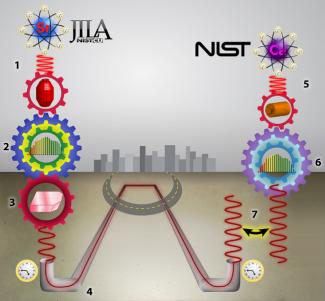By late 2006, Fellow Jun Ye’s clock team had raised the accuracy of its strontium (Sr)-lattice atomic clock to be just shy of that of the nation’s primary time and frequency standard, the NIST-F1 cesium (Cs) fountain clock. Graduate students Marty Boyd and Andrew Ludlow led the effort to improve the clock’s accuracy. But then, the clock team had to spend another year proving that its imporved clock would neither gain nor lose a second in more than 200 million years — thus surpassing the NIST-F1 Cs fountain clock. In the race to create the world’s best optical atomic clock, every detail needs to be ironed out.
After Boyd and his colleagues tested their clock at JILA and showed that it could reach an accuracy level approaching that of the Cs fountain clock, they used a fiber optic link to compare the clock’s performance with a hydrogen maser calibrated to the NIST-F1. However, their ability to assess the accuracy of their clock was hindered by the performance limits of the calibrated hydrogen maser.
Meanwhile, graduate student Seth Foreman and his colleagues had been busy improving the transmission of optical clock signals across the fiber optic network between NIST and JILA. By mid-2007, Foreman’s time-transfer team had improved the noise cancellation of the network by a hundredfold. This meant that the network was capable of precisely and accurately transferring optical atomic clock signals between JILA and NIST.
This development allowed the clock team to devise a system to compare the performance of the Sr lattice clock with a NIST optical clock that is based on neutral calcium (Ca) atoms. The combined clock system, shown schematically in the figure here, allowed the researchers to make very precise comparisons between the signals from each clock. Both atomic clocks drove the phases of their respective optical frequency combs, a.k.a. clock gears. The frequency comb at JILA then transferred its phase to a continuous-wave laser, whose light was sent to NIST via the high-performance fiber link. Researchers then measured exactly how well the frequency of the transmitted light matched up with the NIST frequency comb.
Graduate student Andrew Ludlow led the rigorous clock evaluation project. The evaluation indicated that the JILA Sr-lattice clock was even more accurate than the Cs fountain atomic clock. This development was particularly exciting because the clock team had already proved that its clock was more precise (i.e., measurements of its time were more exact and reproducible) than the Cs fountain clock.
The validation of the Sr-lattice clock’s accuracy set the stage for another comparison —this time with NIST’s single ion mercury clock. The mercury clock has thus far exhibited the highest accuracy ever measured. To prepare for this important test, the Ye group’s clock team is continuing to enhance the accuracy and precision of its Sr clock. - Julie Phillips



 The Physics Frontiers Centers (PFC) program supports university-based centers and institutes where the collective efforts of a larger group of individuals can enable transformational advances in the most promising research areas. The program is designed to foster major breakthroughs at the intellectual frontiers of physics by providing needed resources such as combinations of talents, skills, disciplines, and/or specialized infrastructure, not usually available to individual investigators or small groups, in an environment in which the collective efforts of the larger group can be shown to be seminal to promoting significant progress in the science and the education of students. PFCs also include creative, substantive activities aimed at enhancing education, broadening participation of traditionally underrepresented groups, and outreach to the scientific community and general public.
The Physics Frontiers Centers (PFC) program supports university-based centers and institutes where the collective efforts of a larger group of individuals can enable transformational advances in the most promising research areas. The program is designed to foster major breakthroughs at the intellectual frontiers of physics by providing needed resources such as combinations of talents, skills, disciplines, and/or specialized infrastructure, not usually available to individual investigators or small groups, in an environment in which the collective efforts of the larger group can be shown to be seminal to promoting significant progress in the science and the education of students. PFCs also include creative, substantive activities aimed at enhancing education, broadening participation of traditionally underrepresented groups, and outreach to the scientific community and general public.